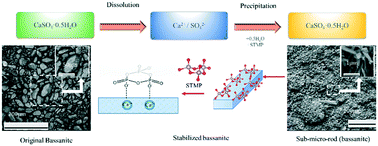当前位置:
X-MOL 学术
›
CrystEngComm
›
论文详情
Our official English website, www.x-mol.net, welcomes your feedback! (Note: you will need to create a separate account there.)
Retardation behavior of hydration of calcium sulfate hemihydrate (bassanite) induced by sodium trimetaphosphate (STMP)
CrystEngComm ( IF 3.1 ) Pub Date : 2018-02-02 00:00:00 , DOI: 10.1039/c7ce02144e Wei Chen 1, 2, 3, 4, 5 , Yi-nan Wu 1, 2, 3, 4, 5 , Bingru Zhang 1, 2, 3, 4, 5 , Ying Wang 1, 2, 3, 4, 5 , Fengting Li 1, 2, 3, 4, 5 , Zeming Qi 6, 7, 8, 9
CrystEngComm ( IF 3.1 ) Pub Date : 2018-02-02 00:00:00 , DOI: 10.1039/c7ce02144e Wei Chen 1, 2, 3, 4, 5 , Yi-nan Wu 1, 2, 3, 4, 5 , Bingru Zhang 1, 2, 3, 4, 5 , Ying Wang 1, 2, 3, 4, 5 , Fengting Li 1, 2, 3, 4, 5 , Zeming Qi 6, 7, 8, 9
Affiliation

|
The sub-micro crystals of a bassanite intermediate were isolated through the introduction of sodium trimetaphosphate (STMP) during the hydration process of bulk bassanite. The particle size and morphology of precipitates were first checked by scanning electron microscopy. The particle size was found to be significantly reduced with increments of STMP, and the majority of the precipitates at a >80 mM STMP addition level had sub-micro size. The length, height, and width of the crystals were determined to be ∼1 μm, ∼150 nm, and ∼300 nm, respectively, by atomic force microscopy. Surface structural information at the molecular level was then obtained by diffuse reflectance infrared Fourier transform spectroscopy. Afterwards, the crystal structure evolution with different amounts of STMP was determined by wide angle X-ray diffraction. Both analytical results show that the final precipitated sub-micro rods (100 mM STMP) are almost all bassanite rather than gypsum. Moreover, the multipeak deconvolution of the WAXD patterns presents a quantitative analysis of the weight percent of bassanite in the final precipitates. The final concentration of bassanite is close to 100% (100 mM STMP). Based on these results, the hydration process of bulk bassanite can be described as the dissolution of original bulk bassanite, the formation of bassanite sub-micro rods, and finally the self-assembly of the sub-micro rods along the c-axis to form gypsum micro-crystals without the additive.
中文翻译:

三偏磷酸钠(STMP)诱导的半水合硫酸钙(玄武岩)的水合延迟行为
在块状重水铝石的水合过程中,通过引入三偏磷酸钠(STMP)分离了重水铝石中间体的亚微晶。首先通过扫描电子显微镜检查沉淀物的粒度和形态。发现颗粒的大小随STMP的增加而显着减小,并且在> 80 mM的STMP添加水平下,大多数沉淀物具有亚微米尺寸。通过原子力显微镜测定,晶体的长度,高度和宽度分别为〜1μm,〜150nm和〜300nm。然后通过漫反射红外傅里叶变换光谱法获得分子水平的表面结构信息。此后,通过广角X射线衍射确定具有不同量的STMP的晶体结构演变。两项分析结果均表明,最终沉淀出的亚微棒(100 mM STMP)几乎都是重钙铝石而不是石膏。此外,WAXD模式的多峰解卷积对最终沉淀物中重晶石的重量百分比进行了定量分析。重晶石的最终浓度接近100%(100 mM STMP)。基于这些结果,块状重晶石的水化过程可以描述为原始块状重晶石的溶解,重晶石亚微棒的形成,以及最终亚微棒沿硅藻土的自组装。重晶石的最终浓度接近100%(100 mM STMP)。基于这些结果,块状重晶石的水化过程可以描述为原始块状重晶石的溶解,重晶石亚微棒的形成,以及最终亚微棒沿硅藻土的自组装。重晶石的最终浓度接近100%(100 mM STMP)。基于这些结果,块状重晶石的水化过程可以描述为原始块状重晶石的溶解,重晶石亚微棒的形成,以及最终亚微棒沿硅藻土的自组装。c轴形成不含添加剂的石膏微晶。
更新日期:2018-02-02
中文翻译:

三偏磷酸钠(STMP)诱导的半水合硫酸钙(玄武岩)的水合延迟行为
在块状重水铝石的水合过程中,通过引入三偏磷酸钠(STMP)分离了重水铝石中间体的亚微晶。首先通过扫描电子显微镜检查沉淀物的粒度和形态。发现颗粒的大小随STMP的增加而显着减小,并且在> 80 mM的STMP添加水平下,大多数沉淀物具有亚微米尺寸。通过原子力显微镜测定,晶体的长度,高度和宽度分别为〜1μm,〜150nm和〜300nm。然后通过漫反射红外傅里叶变换光谱法获得分子水平的表面结构信息。此后,通过广角X射线衍射确定具有不同量的STMP的晶体结构演变。两项分析结果均表明,最终沉淀出的亚微棒(100 mM STMP)几乎都是重钙铝石而不是石膏。此外,WAXD模式的多峰解卷积对最终沉淀物中重晶石的重量百分比进行了定量分析。重晶石的最终浓度接近100%(100 mM STMP)。基于这些结果,块状重晶石的水化过程可以描述为原始块状重晶石的溶解,重晶石亚微棒的形成,以及最终亚微棒沿硅藻土的自组装。重晶石的最终浓度接近100%(100 mM STMP)。基于这些结果,块状重晶石的水化过程可以描述为原始块状重晶石的溶解,重晶石亚微棒的形成,以及最终亚微棒沿硅藻土的自组装。重晶石的最终浓度接近100%(100 mM STMP)。基于这些结果,块状重晶石的水化过程可以描述为原始块状重晶石的溶解,重晶石亚微棒的形成,以及最终亚微棒沿硅藻土的自组装。c轴形成不含添加剂的石膏微晶。



























 京公网安备 11010802027423号
京公网安备 11010802027423号